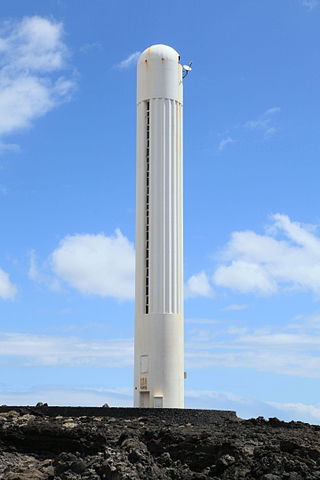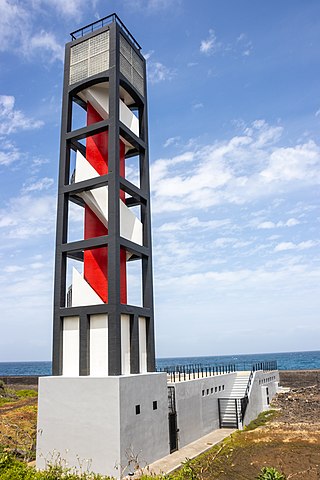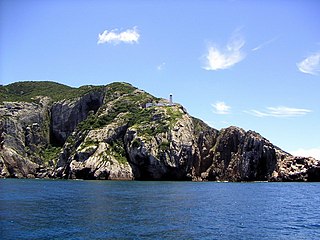
Oranjestad, the capital and most populous of Aruba's eight regions, is located on the southwestern coast of the island. In Papiamento, the local language, Oranjestad is commonly referred to as "Playa" by the locals.

Oranjestad is a small town of 1,038 inhabitants; it is the capital and largest town of the island of Sint Eustatius in the Caribbean Netherlands. It is not to be confused with the far larger Oranjestad in Aruba.

The California Lighthouse, known by locals as Faro stands tall on a limestone plateau at Hudishibana, near Arashi Beach and Sasariwichi dunes on the northwestern tip of Aruba. It holds the distinction of being the tallest structure in Aruba. This lighthouse derives its name from a British steamship, S.S. California, which sank in 1891, predating the lighthouse's construction. The lighthouse was specifically erected to prevent similar tragedies. In May 2016, the lighthouse underwent a restoration, coinciding with the 100th anniversary of its completion.

Seroe Colorado is a village situated at the southeastern tip of Aruba, an island located in the Dutch Caribbean. Nowadays, it is known for the Anchor in Memory to All Seamen. Historically, between 1878 and 1914, Seroe Colorado served as the location for the Colorado Guano Mine, which was involved in the extraction of guano. Additionally, the Seroe Colorado Lighthouse can be found in this village, serving as a prominent landmark.

Planier Light is an active lighthouse on the small Île de Planier, 13 kilometres (8.1 mi) from Marseille, Bouches-du-Rhône, France. At a height of 216 feet (66 m) it is the twelfth-tallest "traditional lighthouse" in the world.

Lange Jaap, also known as Kijkduin Light or Den Helder Light, is an active lighthouse near Fort Kijkduin in Huisduinen, Netherlands. At a height of 63.5 metres (208.2 ft) it is one of the tallest "traditional lighthouses" in the world. For almost a century, from 1878 to 1974, it was the tallest lighthouse in the Netherlands, until the construction of the Maasvlakte Light. According to The Lighthouse Directory it is the tallest non-skeletal cast-iron lighthouse in the world.

Richmond River Light, also known as Ballina Head Light and Ballina Light, is an active lighthouse located at Ballina Head, a headland in Ballina, New South Wales, Australia. The headland is at the northern side of the entrance to the Richmond River. It used to serve to guide ships into the river port and is used also serves as a leading light into the river, together with a steamer's masthead lantern with a 200 mm lens which is raised on a wooden structure 30 metres (98 ft) from it.

Creal Reef Light is an active lighthouse located at Creal Reef, a planar reef about 150 kilometres (93 mi) east of Mackay, Queensland, Australia. It guides ships outgoing from Mackay into Hydrographers Passage, a deep water channel east of Mackay. The structure is a stainless steel tower, which also serves as a daymark and carries a racon.

Wyborn Reef Light is an active lighthouse located at Wyborn Reef, formerly known as Y Reef, about 16 kilometres (9.9 mi) southeast of Albany Island, east of the tip of Cape York Peninsula, Queensland, Australia. It marks the entrance to the Albany Passage. The lighthouse was constructed in 1938 and upgraded in 1991 and 1995. The structure is a stainless steel tower with a fiberglass hut within the framework, carrying a lantern.

Nieuwe Sluis is a Dutch lighthouse in the Nieuwesluis community, a few kilometres west of Breskens, Zeeland, and the southernmost in the country.

Lågskär Lighthouse is an automated lighthouse located on the north side of Lågskär, one of Finland's Åland in the Sea of Åland of the Baltic. It is the only striking feature on Lågskär on the generally uninhabited island.

The Arenas Blancas Lighthouse is an active lighthouse on the Canary island of La Palma in the municipality of Villa de Mazo, near the village of La Salemera. The larger settlement of Mazo lies 8 km (5.0 mi) to the north-west.

The Punta Sardina Lighthouse is an active lighthouse on the Canary island of Gran Canaria. It is located north of the small town of Sardina, in the municipality of Gáldar. The Punta Sardina light marks the north-western extremity of the island, and lies between the Punta del Castillete lighthouse near Puerto de Mogán to the south and the La Isleta lighthouse of Las Palmas to the east.

The Puerto de la Cruz Lighthouse is an active lighthouse in Puerto de la Cruz on the northern coast of Tenerife in the Canary Islands. This modern lighthouse is situated within a seafront car park, to the west of the small port in the town. It is one of seven lighthouses which mark the coastline of Tenerife, and lies between two other modern lighthouses of Punta del Hidalgo to the northeast, and Buenavista to the west.

The San Cristóbal Lighthouse is an active lighthouse on the Spanish island of La Gomera in the Canary islands. The current lighthouse is the second to have been constructed on the rocky headland of Punta de San Cristóbal, on the eastern side of the island, overlooking the approaches to San Sebastián de La Gomera, the main port and capital of La Gomera.

Blackhead Lighthouse is a listed lighthouse built at the turn of the 20th century, near Whitehead in County Antrim, Northern Ireland. It marks the very northern end of Belfast Lough where it opens out into the North Channel that separates Northern Ireland and Scotland. The active lighthouse is managed by the Commissioners of Irish Lights, where it is named as the Blackhead Antrim Lighthouse to distinguish it from the more modern Blackhead lighthouse in County Clare.

Cabo Frio Lighthouse is an active lighthouse located on the southern point of the Ilha do Cabo Frio, called Focinho do Cabo, in the municipality of Arraial do Cabo, Brazil.

The discovery of guano on Klein Curaçao by John Godden in 1871, sparked a "guano mania" across the Antillean islands, including Curaçao. In 1874, J. H. Waters Gravenhorst is credited with the discovery of guano in Aruba, although an earlier interest was shown by an American named S.R. Kimball in 1859. The exact outcome of Kimball's efforts remains uncertain. This ultimately led to the incorporation of a limited company on Curaçao, known as Aruba Phosphate Company on December 18, 1879.






















